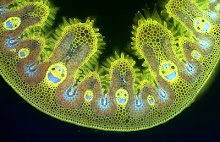The vivid colours and satisfying geometry of florists’ auriculas have fascinated gardeners for almost four and a half centuries and over the last few decades they have undergone something of a revival. The distinctive white centre of the flower is the product of a waxy secretion known botanically as farina (the ‘paste’ in florist’s jargon). The so-called 'alpine' varieties have delicately shaded outer petals that are characterised by rich, clear colours and a velvety texture, while the 'edged' varieties have green petals, with sometimes in rim of farina on their edge. Petals have evolved from leaves and the green-flowered varieties are mutants, where the petals have reverted to their ancestral form. The auricula in the picture is a so-called fancy variety known as Sweet Pastures, which combines several distinctive florist’s auricula characters in a single bloom. Auriculas are reputed to have been brought to England from Europe around 1570 by Flemish weavers or perhaps refugees and became popular plants, with florist's societies soon being established with the aim of breeding varieties to exacting standards of perfection. These are as strict as those defined by dog breeders at Crufts; for example, auricula flowers must always be 'thrum-eyed', with a ring of five stamens in the floral tube aperture, and 'pin-eyed' varieties, where the single stigma occupies the same position, are discarded. By the late 18th. century the best varieties were changing hands at around £20 per plant, an immense amount of money at that time. The plants were bred and shown competitively (as they still are) and some gardens in large country houses even had covered auricula ‘theatres’ where collections flowers could be displayed - see http://www.auriculaandprimula.org.uk/history.html and http://www.nationaltrust.org.uk/main/w-vh/w-visits/w-findaplace/w-calkeabbey.htm A National Auricula Society was founded in 1873, which still thrives as the National Primula and Auricula Society see http://www.auriculaandprimula.org.uk/ and http://www.auriculas.org.uk/
Florists auriculas are probably hybrids between the wild alpine Primula auricula (below) and Primula rubra, possibly with a further cross to another unknown species.
Some year ago I did some research work for a now-defunct company called Neo Plants, which specialised in micropropagation of garden plants - a sterile-culture propagation technique which removes viruses and produces very vigorous, healthy stock. Auricula varieties are traditionally propagated by division and stem cuttings and over time the clonal offspring accumulate viruses which gradually diminish their vigour. Neo Plants got their hands on some old auricula varieties and micropropagated them, producing revitalised and very vigorous plants which flowered profusely. At one time I had a small greenhouse full of these delightful flowers and the fragrance that they produced on a spring morning when they were all in bloom was memorable. I still have a few, and their flowers are something I look forward to all through the winter.















